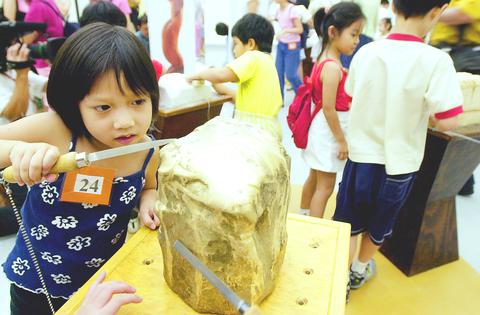"How can there be a bird hidden in the stone?" children may wonder when sculptor Constantin Brancusi's Bird in Space welcomes them at the entrance to "L'oiseau Cache dans la Pierre -- Un espace-jeu autour de l'oeuvre de Brancusi" (The Bird Hidden in the Stone -- A play space based on the works of Brancusi) at the Taipei Fine Arts Museum.
The combined exhibition and educational program designed by France's Georges Pompidou Center is coming to Taiwan for the first time on its world tour that started in 1995. The show is intended to familiarize children aged 6 to 12 with the creative process of sculpting through simple games inspired by concepts typical in Brancusi's work.

PHOTO:CHEN CHEN-CHANG, TAIPEI TIMES
Born in Romania in 1876, Brancusi moved to Paris in 1904, where he lived and worked until his death in 1957. His works can now be seen in museums around the world.
The artist's intention was to embody a timeless and universal sense of mystery and of the sacred. "Do not look for obscure formulas or mysteries. I give you pure joy. Look at my works until you see them," he has been quoted as saying.
Birds are the theme of 27 of his works. Beginning in 1918, Brancusi made a series of four Golden Birds. The bronze surface of Golden Birds (1919), on view at the museum, is highly polished to mirror the surroundings, as Brancusi believed that his sculpture should draw in the space around it to be complete. The works' pedestals are made into various geometric shapes which later evolved into hexahedrons that make up his best-known work Endless Column.
Hexahedrons are also an important aspect in the educational part of the program.
The Bird in Space series, sculpted between 1923 and 1940, sees the complete abstraction of Brancusi's birds. They have become spindle-like birds without wings and feathers -- capturing a bird in flight instead of its body.
The program includes six educational game areas where children can explore the basics of Brancusi's sculptures.
"Sculpting with Light" has viewers stand in a dark cubicle with a column composed of a stack of several hexahedrons. They control the light that falls on the column with a panel of buttons. This shows how different lights affects the appearance of the sculpture.
The distortions of their own image in "Magic Mirrors" provides the young participants not only with comic relief but also demonstrates the effects of a number of reflecting surfaces tilting at different angles.
Again employing Brancusi's characteristic geometrical blocks, "Put the Shapes Together" has children pile geometrical blocks into a column, which helps kids to think about spatial relations.
The walls of the game areas are decorated with photos of Brancusi's studio. One shows the white marble of Bird in Space against a dark background reflecting the light in a sharp line. These photos further illustrate the emphasis Brancusi put on the interaction between the works and their surroundings.
There are no rules to any of the games, Isabelle Frantz-Marty, the event's organizer, said during Thursday's preview. She encouraged teachers and parents not to direct children on what they should do with the materials.
"These are games, children are here to play. That's the spirit of this program," she said.
Art Notes:
What: L'oiseau Cache dans la Pierre -- Un espace-jeu autour de l'oeuvre de Brancusi (The Bird Hidden in the Stone -- A play space based on the works of Brancusi) (藏在石頭裡的鳥 -- 關於布朗庫西作品的遊戲空間)
Where: 3A, Taipei Fine Arts Museum (台北市立美術館), 181 Chungshan N. Rd., Sec. 3, Taipie(台北市中山北路3段181號)
When: Until Sept. 23

June 2 to June 8 Taiwan’s woodcutters believe that if they see even one speck of red in their cooked rice, no matter how small, an accident is going to happen. Peng Chin-tian (彭錦田) swears that this has proven to be true at every stop during his decades-long career in the logging industry. Along with mining, timber harvesting was once considered the most dangerous profession in Taiwan. Not only were mishaps common during all stages of processing, it was difficult to transport the injured to get medical treatment. Many died during the arduous journey. Peng recounts some of his accidents in

“Why does Taiwan identity decline?”a group of researchers lead by University of Nevada political scientist Austin Wang (王宏恩) asked in a recent paper. After all, it is not difficult to explain the rise in Taiwanese identity after the early 1990s. But no model predicted its decline during the 2016-2018 period, they say. After testing various alternative explanations, Wang et al argue that the fall-off in Taiwanese identity during that period is related to voter hedging based on the performance of the Democratic Progressive Party (DPP). Since the DPP is perceived as the guardian of Taiwan identity, when it performs well,

A short walk beneath the dense Amazon canopy, the forest abruptly opens up. Fallen logs are rotting, the trees grow sparser and the temperature rises in places sunlight hits the ground. This is what 24 years of severe drought looks like in the world’s largest rainforest. But this patch of degraded forest, about the size of a soccer field, is a scientific experiment. Launched in 2000 by Brazilian and British scientists, Esecaflor — short for “Forest Drought Study Project” in Portuguese — set out to simulate a future in which the changing climate could deplete the Amazon of rainfall. It is

The Taiwan People’s Party (TPP) on May 18 held a rally in Taichung to mark the anniversary of President William Lai’s (賴清德) inauguration on May 20. The title of the rally could be loosely translated to “May 18 recall fraudulent goods” (518退貨ㄌㄨㄚˋ!). Unlike in English, where the terms are the same, “recall” (退貨) in this context refers to product recalls due to damaged, defective or fraudulent merchandise, not the political recalls (罷免) currently dominating the headlines. I attended the rally to determine if the impression was correct that the TPP under party Chairman Huang Kuo-Chang (黃國昌) had little of a